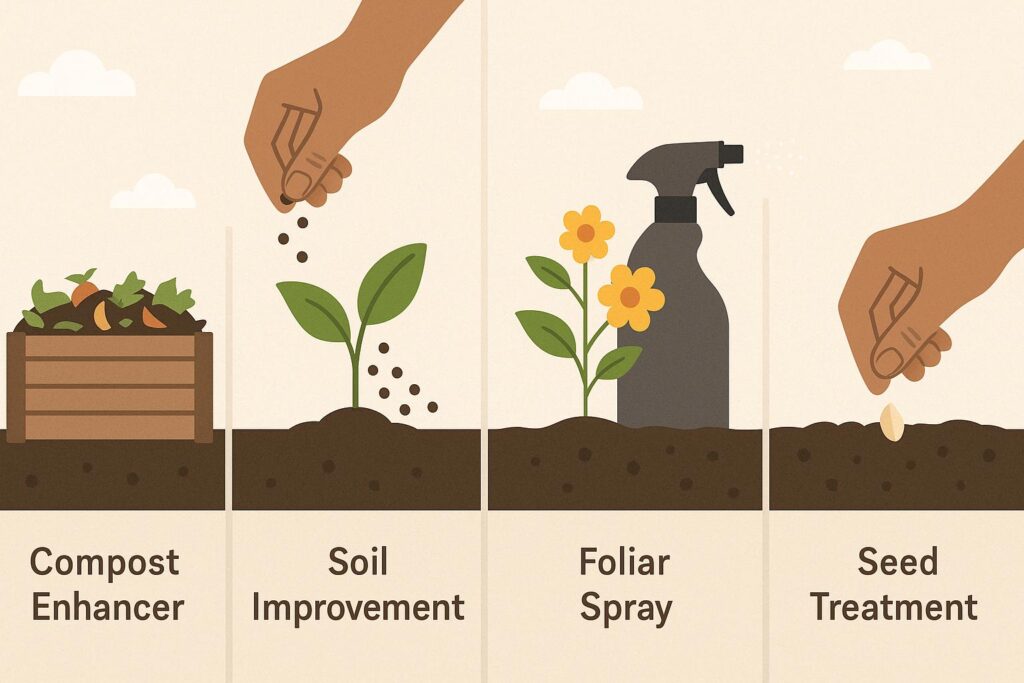Humic acids are gaining recognition across agriculture, horticulture, and soil science for their versatile applications and unmatched ability to enhance soil and plant health. Extracted from natural sources like leonardite and peat, these organic molecules have transformed how growers approach soil fertility, composting, and crop production. But the value of humic acids goes far beyond traditional soil amendment. From improving compost efficiency to boosting seed germination, their multifaceted role in modern farming is both practical and profound.
Examining humic acid’s chemical characteristics, biological effects, and practical outcomes is necessary to fully comprehend its range of applications; these factors together are reshaping sustainable farming methods all over the world.
The Science Behind Humic Acids and Their Unique Properties
With a combination of carbon, hydrogen, oxygen, nitrogen, and sulfur, humic acids are the biggest and most potent part of humic agents. They are strong natural chelators that improve nutrient availability and soil structure because of their capacity to bind with minerals and organic materials in the soil.
Key properties of humic acids include:
- High cation exchange capacity, allowing soils to hold more nutrients.
- Natural chelation, making micronutrients more accessible to plant roots.
Humic acids are frequently referred to as nature’s soil conditioners for these reasons. They improve the environment for plants and helpful microbes by working underneath the surface.
Research from the International Humic Substances Society highlights how humic acids stimulate microbial activity and enhance nutrient cycling, leading to more resilient and fertile soils across various farming systems.
Humic Acids as Compost Enhancers: Boosting Organic Matter Quality
Composting is an age-old practice, but integrating humic acids into composting processes elevates the quality of the final product. By accelerating microbial activity, humic acids speed up the breakdown of organic material and improve the nutrient profile of compost.
When added to compost piles, humic acids help:
- Balance the carbon-to-nitrogen ratio, critical for efficient decomposition.
- Stabilize nutrients to prevent leaching and loss during the composting process.
When humic acids were added to the mix, we observed increased compost maturity rates and a discernible improvement in the final compost’s ability to retain moisture. The resulting humus-rich compost provided better soil conditioning qualities, improving plant resilience and growth.
Purchasing Humus Plant Growth Promoter changed everything for growers trying to get the most out of their compost. Our composting systems were strengthened by the humic compounds, which also improved microbial diversity in the pile and decreased odor problems. This is an important but frequently disregarded aspect of producing high-quality compost.
Enhancing Seed Germination and Early Plant Growth
Applying humic acids to seeds has become a viable way to encourage quick germination and the development of healthy seedlings. Applying a humic acid solution to seeds enhances their ability to absorb water and increases the activity of enzymes that support growth.
Our trials showed clear advantages when using humic acids as a seed treatment, such as:
- Faster germination rates and uniform sprouting.
- Enhanced root elongation and early nutrient uptake.
This effect is backed by research published by Frontiers in Plant Science, which reports that humic substances can stimulate root growth hormones, promoting robust seedling development across various crops. Especially in crops sensitive to early-stage stress, this advantage provides a strong start that supports better yields down the line.
Strengthening Soil Health and Organic Carbon Content
One of the less discussed but highly valuable impacts of humic acids is their role in enriching soil organic carbon — a key indicator of soil health. Soils rich in organic carbon have better structure, water retention, and biological activity.
Humic acids contribute to this by:
- Enhancing humus formation, the stable fraction of organic matter.
- Supporting microbial communities that cycle carbon and nutrients efficiently.
Increasing soil carbon contributes to climate-smart agriculture in addition to being good for plant health. A significant figure in water-limited areas, increasing soil organic carbon by just 1% can boost water-holding capacity by up to 25,000 gallons per acre, according to global agriculture data.
“Healthy soil is more than a foundation for plants — it’s the living reservoir of resilience, and humic acids are one of its finest allies.”
Supporting Plant Immunity and Reducing Environmental Stress
Humic acids affect the physical characteristics of soil by encouraging aggregation and decreasing compaction. Particularly in sandy or disturbed soils, these modifications enhance water infiltration and retention. This results in improved moisture management and lower irrigation requirements for farmers cultivating marginal soils.
We observed that crops treated with humic acids showed:
- Increased tolerance to water stress.
- Reduced signs of nutrient deficiency during critical growth stages.
This enhancement in stress resistance is linked to improved root architecture and nutrient assimilation — two factors that directly influence how well a plant can withstand adverse conditions.
Improving Water Retention and Soil Porosity
Humic acids influence the physical properties of soil by promoting aggregation and reducing compaction. Particularly in sandy or disturbed soils, these modifications enhance water infiltration and retention. This results in improved moisture management and lower irrigation requirements for farmers cultivating marginal soils
By integrating humic acids into our soil treatment plans, we noted:
- Higher water retention during dry spells.
- Easier tillage and root penetration due to improved soil structure.
These benefits aligned with findings from sustainable farming studies by the Food and Agriculture Organization, which emphasize soil conditioning as a cornerstone of long-term agricultural productivity.
FAQs
- Can humic acids be mixed with fertilizers or pesticides?
Yes, humic acids are compatible with many fertilizers and biological treatments. However, compatibility testing is advised when mixing with chemical pesticides. - How often should humic acids be applied to soil or crops?
Application frequency depends on the intended use. For composting and soil improvement, periodic application works well, while foliar or seed treatments may be applied at specific growth stages. - Are humic acids suitable for organic farming?
Yes, naturally derived humic acids comply with organic farming standards and are commonly used in certified organic systems. - What is the best method of applying humic acids?
They can be applied directly to soil, as a foliar spray, or used in seed treatments. The choice depends on the target benefit — soil health improvement, nutrient uptake, or early plant growth.
Beyond the Basics: Exploring Innovative Uses of Humic Acids
As we investigated various uses, we came across new methods that take advantage of humic acids’ adaptability outside of their traditional applications. For instance, hydroponic farmers have begun adding humic acid extracts to nutrient solutions after discovering advantages in the efficiency of nutrient uptake and the health of the root zone.
Humic acids are employed in soil-building techniques that prioritize biodiversity and low chemical inputs in regenerative agricultural systems. Because of their compatibility with microbial inoculants and biological fertilizers, they are preferred by practitioners who want to restore soil rather than just maintain it.
Progressive growers now use terms like biostimulant synergy, which emphasizes their function in boosting the efficacy of other biological agents, and cationic bridging dynamics, which describes how humic acids affect soil particle bonding.
The Growing Relevance of Humic Acids in Sustainable Farming
Global adoption of humic acids is being driven by growing awareness of soil degradation, climate change, and the need for sustainable inputs. They work very well with both conventional and organic agricultural models, providing a balance between ecological responsibility and yield.
A substantial movement towards biostimulant-based agriculture is evident from recent surveys, which show that more than 45% of farmers utilizing soil amendments in regenerative techniques incorporate humic compounds into their management plans.
Because of their many uses, including improving compost, increasing seed germination, enriching soils, and raising plant resilience, humic acids are a key component of the shift to healthier, more sustainable agricultural practices. They are a long-term value for growers who are dedicated to fostering both crops and the environment since they offer layered benefits that touch almost every facet of plant growth and soil management.


